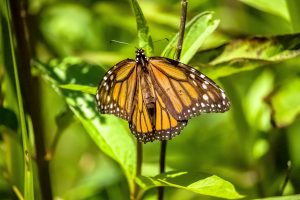
Climate Experience:
Citizen has noticed that butterflies are emerging earlier than they used to.
Explanation:
- Butterflies are emerging 10 days earlier in spring than they did in 1945 (10 days earlier for each degree of temp rise).[1]
- Increased temperatures force a premature emergence of butterflies and a body size reduction.[2]
- The region has experienced18 consecutive years with temperatures above the long-term average.[3]
- Changes are consistent with butterflies in other regions of the world.[4]
- Butterflies are losing 2.3% of their lifespan every decade.[5]
Ramifications:
- If traditional butterfly food sources do not emerge early too, butterflies may soon emerge to early to survive.[6]
- Up to 92% of butterflies species are expected to be threatened by climate change.[7]
What can be done?
- Email your local MP and tell them that action on climate is important to you and explain the impacts being felt in your area. One email might not feel like much but most politicians consider it to be representative of 100 citizens.
- Get involved with local groups taking action on climate, in this community look out for …..
- Help support the Act on Climate collective by donating; we are leading the charge for climate action. Your donation helps in advancing policies that prevent climate change from getting worse, we aim to empower communities and build a strong pro-climate-action constituency that governments can’t ignore, and as an added bonus it’s tax-deductable.
- Get involved with Act on Climate. We meet every Monday at 6pm (upstairs at 312 Smith St, Collingwood) and welcome all newcomers to join in the fight for climate justice. If you are unable to attend, follow us on Facebook, Twitter and Instagram to keep up with the latest campaign.
* We aim to keep our material as accurate and as relevant as possible. Working with climate science, a field that is being constantly updated, keeps us on our toes. Information on this site was gathered on June 1 2019; if you notice information that needs updating please let us know. For the full reference list please see the following.
______________________
[1]Michael R Kearney et al., “Early Emergence in a Butterfly Causally Linked to Anthropogenic Warming,” Biology Letters6, no. 5 (2010).674.
[2]W James Davies, “Multiple Temperature Effects on Phenology and Body Size in Wild Butterflies Predict a Complex Response to Climate Change,” Ecology (2019).1.
[3]“Australian Climate Change Site Data – Melbourne Regional Office”, Bureau of Meteorology, accessed April 23 2019, http://www.bom.gov.au/cgi-bin/climate/hqsites/site_data.cgi?variable=maxT&area=aus&station=086071&dtype=anom&period=annual&ave_yr=0
[4]DB Roy and TH Sparks, “Phenology of British Butterflies and Climate Change,” Global change biology6, no. 4 (2000).406.
[5]Daniella Brandy, “10 ways climate change is affecting Australia’s wildlife, according to science,” Business Insider Australia, published March 19, 2018, https://www.businessinsider.com.au/climate-change-impact-australian-wildlife-3-2018-3
[6]Stephen J Brooks et al., “The Influence of Life History Traits on the Phenological Response of British Butterflies to Climate Variability since the Late‐19th Century,” Ecography40, no. 10 (2017).1153.
[7]Linda J Beaumont and Lesley Hughes, “Potential Changes in the Distributions of Latitudinally Restricted Australian Butterfly Species in Response to Climate Change,” Global Change Biology8, no. 10 (2002).954.
